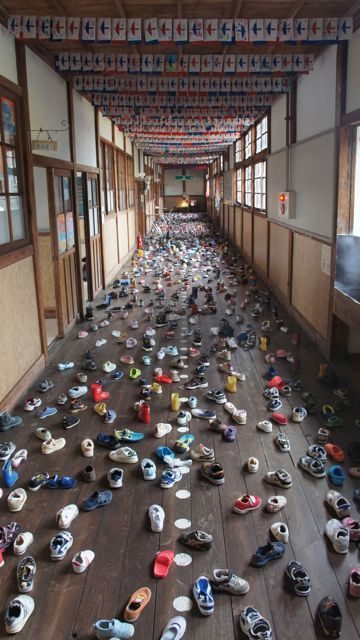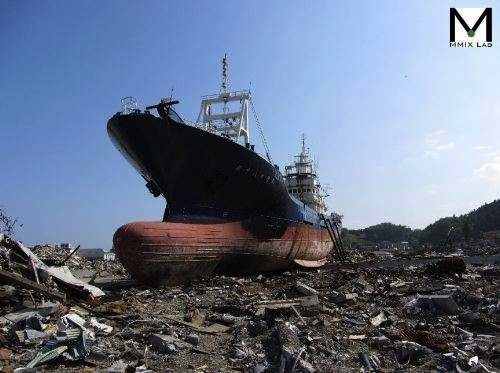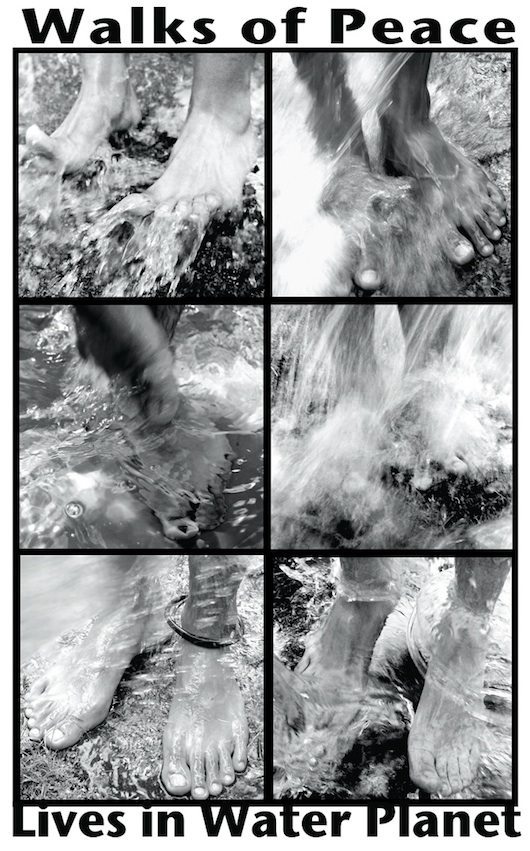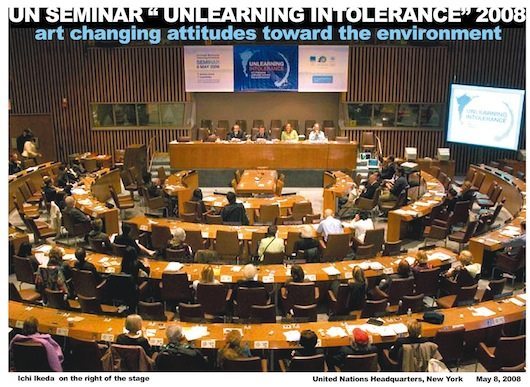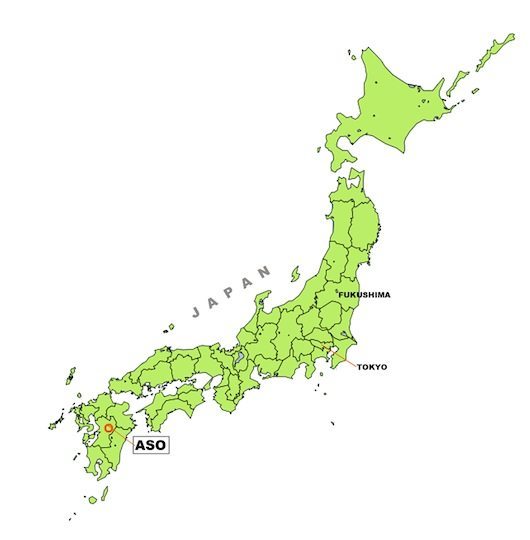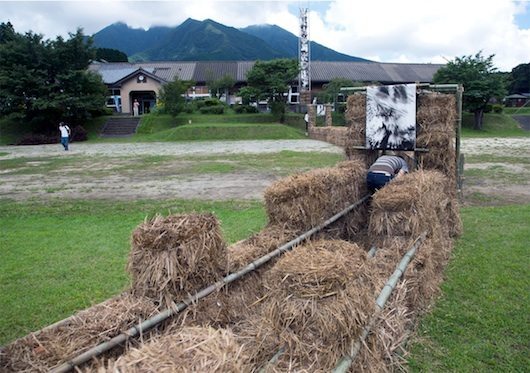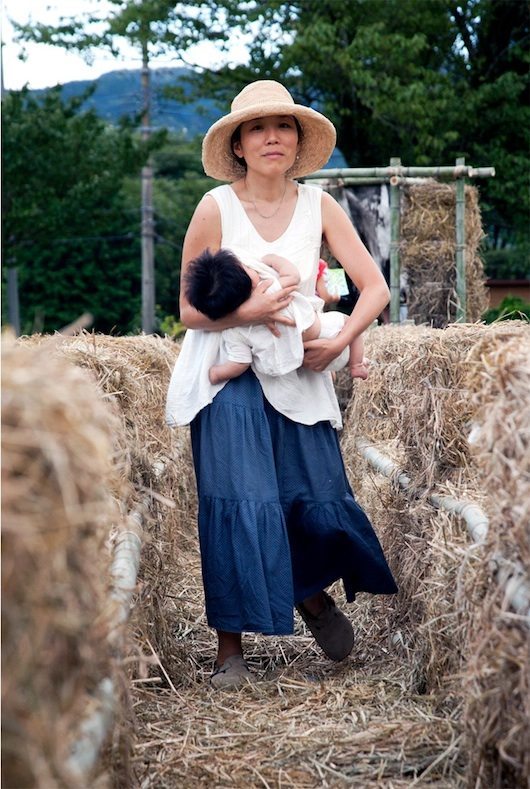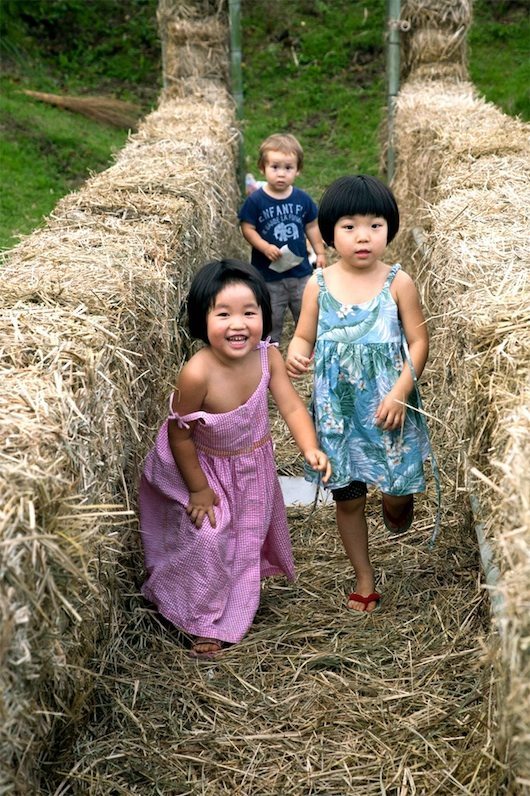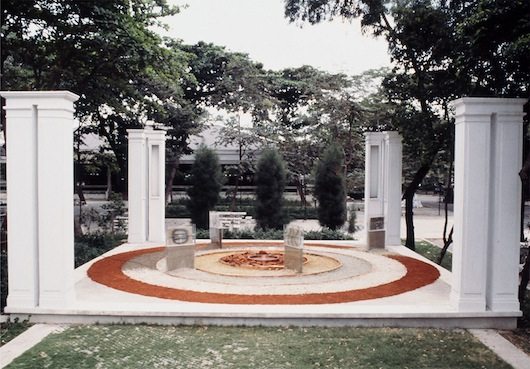Title: A NEW PERSPECTIVE: ICHI IKEDA
Editor’s Note:
Japanese art writer and publisher Hiroko Shimizu’s essay is in two parts. The first part is a brief overview of her country’s nuclear issues and its artists working with these issues, both post-Hiroshima and post-Fukushima (site of the disastrous earthquake-tsunami-nuclear power plant crisis of March 2011). Following her survey, Shimizu interviews Ichi Ikeda—one of Japan’s most vocal and well-known environmental artists. A charismatic philosopher-artist, Ikeda exhibits and speaks out on environmental issues internationally—so appreciated that he was invited to speak at the United Nations. For years he has worked with Japanese villagers to create stunning visual metaphors that warn of the scarcity and disproportionate global distribution of clean drinking water. He envisions an alternative view of how to live collectively.
INTRODUCTION

Cherry tree near Fukushima Nuclear Plant, Tomioka-cho, April 2012. (Copyright 2012 The Sankei Shimbun & Sankei Digital)
Country damaged, mountains and rivers remain.
In spring, grass and trees are thick…
Spring View by Du Fu (757 A.D.)
IT HAS BEEN MORE THAN ONE YEAR since the massive earthquake and the tsunami that hit East Japan on March 11, 2011, subsequently causing the unprecedented disaster of the nuclear power plant meltdown. The disaster uprooted the daily lives of people and destroyed the bonds of communities there. In the above quote by Du Fu, the famous Chinese poet; he says that while grieving over the miserable state of the country, he is comforted by the unchanged nature of his homeland. Yet, in part of Fukushima today, the radioactive contamination has created a no-man’s land where nobody will be able to go back home and to nature.
According to a poll by Asahi Shimbun (1), 80% of the people in Japan do not trust the government’s safety measures for nuclear power plants. The eco-fantasy of nuclear energy has collapsed. Information from the government and highly specialized experts has become unreliable.
There is a consensus in favor of denuclearization, in fact there are many diverse opinions and controversies concerning the scope of nuclear energy with relation to the economy, politics, environment, society and culture.
Images of the incidents and people’s suffering repeatedly appear in our daily media. Its flashback burned into our eyes and further to the deep subliminal inside catch us between feeling anger and fear for the future, even though there seems to be no apparent trouble in the everyday life of Tokyo and western areas.
In these circumstances, what would art be able to do?
There are a whole range of artistic activities which reference the disastrous events and recovery. Many artists local, foreign and international, are supporting survivors in various ways. Hundreds of art organizations and volunteer groups visited affected areas to organize workshops and projects with the local people. These activities express the collective voices of the citizens living in temporary housing, also helping them to communicate to each other and recover their traditional culture and communities. In addition, it is remarkable that many umbrella networks like Arts Aid Tohoku, WAWA Project, Art Support Tohoku and 3.11 Arts Action were created as intermediary supporting systems for individual artists and organizations.
Although the anti-nuclear art movements are growing, the majority of the artistic activities after Fukushima are rather to comfort and help those uprooted by supporting their recovery and community regeneration. These activities and their processes collect broader public attention instilling a new role for art in society.
BRIEF OVERVIEW OF ATOMIC AGE ART IN JAPAN
AFTER HIROSHIMA, MANY JAPANESE ARTISTS created work referring to the atomic age. Among them, Iri & Toshi Maruki, a collaborating couple, created a series of paintings in traditional Japanese Sumie style depicting the aftermath of Hiroshima. A huge mural by Taro Okamoto Myth of Tomorrow (1968-69) presented the moment of the atomic explosion juxtaposed with subtle hope for the future. As a Hiroshima victim, Tadashi Tonoshiki created ecologically oriented works against the mass consumption society after World War II. In the Revive Time: Kaki Tree Project by Tatsuo Miyajima, people all over the world participated in workshops to plant kaki (Japanese persimmon) trees–which miraculously survived the Nagasaki bombing—as a symbol of peace. Kenji Yanobe has become famous for his performance of visiting Chernobyl with a Geiger counter, expressing not only ruins and despair but utopia and hope.
Post Fukushima, artist collectives—like Atomic Site (2), and Chimpom express opposition to nuclear problems through various mixed media approaches.
Takashi Murakami (MMIX Lab), living in Sendai, Miyagi, leads the Memorial project in which he tries to preserve monumental objects destroyed by the tsunami, and the Sakura project in which local people plant cherry trees on the line of the tsunami destruction. Shigenobu Yoshida—an artist living in Iwaki, Fukushima, leads the Fukushima Art Project which conveys local children’s voices to the world through postcards and a series of video documentation.
What these art actions express in common, even though facing disastrous consequences, are subtle signs of hope for the future. Actually, despite desperate conditions and a sense of great loss, some sufferers report experiencing a strange feeling of exaltation. Why? People think that it could come from the new sense of solidarity gained from mutual support. Is this linked to an expectation for seeking a more open and self-sustained society during the severe situation?
INTRODUCING ICHI IKEDA
ICHI IKEDA IS AN INTERNATIONALLY KNOWN artist recognized for his work with disappearing water systems. While a lot of attention is paid to the disaster areas, he is working in southern Kyushu, Aso—far from Fukushima. He is working with people who emigrated from urban Tokyo after the tsunami and nuclear incidents, hoping to create a new life and community in a safer, healthier setting.
In the following interview, Ichi Ikeda and I discuss his collaborative work with the new emigrants to Kyushu.
THE INTERVIEW (3)
Hiroko Shimizu (HS): Since the Fukushima incidents, we are confronting fundamental questions like: What have we been doing? Where are we heading?
The environmental destruction caused by this disaster has developed into holistic social issues with discussions extending to the global scale. There are people trying to find new ways for energy but its one year later, and I think there still is a difficulty finding new directions free from the long standing closed system symbolized as nuclear management. How do you think of these questions as an artist?
Ichi Ikeda (II): After the nuclear power plant accidents, many noticed that we had moved beyond what we could control. Many confessed that the safety myth (4) of the nuclear age supported by high-developed technology collapsed.
To tell the truth, earlier in my life, before I became an artist, I belonged to the Kyoto University chemistry laboratory and studied under the world authority on radiation-induced polymerization. I was pretty entangled in high-advanced technology including radiation.
One day an unanticipated explosion occurred during my laboratory work. A test-tube blew up, a water tank burst and the room became flooded. Despite the small scale accident, it showed me that it is difficult to anticipate and control chemical reactions. From this experience, I learned that the more specialized technology developed, the more difficult to settle and envision the accidents.
The Fukushima incidents prompted me to recall this small incident in the laboratory and my connection to radiation. Forty-five years since the laboratory incident, relationships between human life, environment and the increasing complexity of society made it more difficult to anticipate the future events. I suggest that people not get more entangled with societies complexities, and find their ‘primary relation’ to their local environment.
I have been working on this concept of ‘primary relation’ to water since 1995. I wrote the following message for the Fiftieth Anniversary of the United Nations; art calendar;
We the people are to realize that water, source of our lives, is the medium to move beyond borders, everyday customs, histories and cultures, in order to realize the profound exchange between human beings and environment.
I call this thought the “United Waters” an alternative to the United Nations. I believe that water is a media to unite diverse people beyond nations. Further, I have recognized that water art projects can connect human life and environment. Through water art projects, you can find ‘primary relations’ between our life and surrounding environment.
After Fukushima, the idea of having a ‘primary relation’ with earth becomes apparent. Now artists are expected to create artworks with alternative perspective. I feel that I play an important role to go beyond the complications of nuclear power or other forms of high-developed technology.
I. RE-EVALUATING THE BONDS OF COMMUNITY
HS: Since the tsunami and nuclear power plant meltdowns, bonds of the community have been re-evaluated. People were severely damaged in the east part of Japan such as farmers and fisherman who rely on the land and nature. The people who work close to the land have a ‘primary relation,’ as you would describe it, and is very strong.
People want to return to their communities that were swept by the tsunami. Even the refugees who cannot return due to the radioactive contamination hope to return to their hometown and regain their original community. In Tokyo, on the other hand, many people who had normal lives, moved out to the far western part of Japan to create a new populace. What do you think of these opposite movements?
II: I do not think they are opposite. Although their behavior seems headed in opposite directions, they share an important common consciousness generated by the nuclear accidents. They share a profound sense of loss.
Before the incidents, the common consciousness underlying their daily lives was maintained by various activities shared in the community. The accidents in the atomic plants blew up the shared consciousness. The bonds were broken, there was a loss of self-identity; where am I standing in relation to others and the future?
Radioactive contamination deprived the standing point for each individual’s future. To a greater or lesser extent, all people living on the same crusted plate of the earth have been compelled to search for a new starting point beyond the loss.
As an artist creating perspective for the future, I insist on the significance of grasping a starting point—a ‘Potential Point’—a place to reach for beyond our sense of loss.
Some of the refugees are hoping to return to their homeland even though it’s severely damaged. Some moved out to the remote region away from the nuclear site. Regardless of differences among their movement, I see two common factors for moving in search for a potential point: land and community.
Among various movements we must recognize a common attitude towards the land. People moved to Kyushu to try to reconstruct a community.
In the case of South Aso, Kyushu, ca. 1000km southwest of Tokyo, new residents emigrating from Tokyo, are trying to focus on farming and forestry. Away from city life with its complicated systems, they are asking for a potential position in relation to nature. So we could call it ‘Primary Potential Point’, PPP.
II. BUILDING A NEW ENERGY-SELF-SUFFICIENT COMMUNITY
HS: Please explain the new community in South Aso that the people are aiming to build there. What do you think of the people’s activities there?
II: When I visited the South Aso area for the first time, I noticed that new residents and village people were working towards building a sustainable community together. After the accidents more than 50 families moved there to escape from the exposure to radioactive contamination. They were not residents in the area struck by the earthquake and tsunami. They lived in Tokyo, about 200 km away from the nuclear power generation plants, and felt no direct effects of the accident. But they decided to move and plan for a future, considering the earth, their children and grandchildren.
About nine months after the disasters, settlers in the Minami Aso region were still increasing, moving there with hope to create a nuclear power-free community.
In this region, a new perspective for a desirable future is emerging. In my words, ‘primary relation’ with people and environment are taking root. With rich natural resources in the forest, they can realize their prospects. The potential energy here is steadily stored to build new industries from their own resources.
The people there hope to harness a self-sufficient energy production, rather than depend on a centralized energy system. Energy-shift is a common target for new settlers to deal with cooperatively.
III. DEVELOPING A NEW OPEN-SYSTEM OF ALTERNATIVE ENERGY
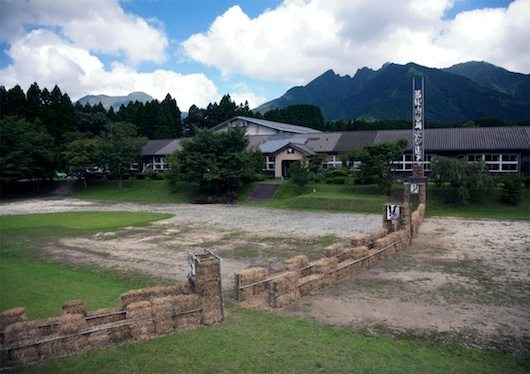
Dormant volcano towering behind ‘L-shaped Walks of Peace’, Ichi Ikeda, Aso, Japan, 2011. (photo by Tatsuro Kodama)
HS: The vulnerability of the closed management system of nuclear plants, which consists of centralized government, specialized experts, and people with economic interests, has been exposed by the Fukushima accident. In terms of the people coming to South Aso sharing common interests for creating a so-called ‘transition town’ or ‘eco-village’, do you think they may also create their own closed circle?
II: Speaking of the energy-shift, we concentrate on denuclearization and conversion to new green energy. For settling this problem, political and economical measures are necessary far beyond individual power. Although there is the assumption that differences among individuals must be highly respected, we know empirically that community people tend to, by placing too much emphasis on sharing the same thought and the same action, form community in a closed system.
We shall see what happens in South Aso. Having begun to create a new model for community, in order to survive after the nuclear accidents, the people of South Aso seem to have avoided the formation of closed community systems. There are two reasons; first, some of their daily activities are incorporated in the Aso Folk School. The closed elementary school was transformed to a place for new people and former students to study regional culture for future generations. This builds cooperative relationships between new and old community members.
Another factor suggesting the possibility of an open community is a strong relationship with networking system like ‘transition town’ spreading nationwide (5) which is connected through the movements of No Nukes.
IV. AN ARTIST WHO MOVES WITH THE EARTH
HS: Is it possible for an artist to express a vision or field free from closed circles or systems? And could you tell me your idea of what kind of field you tried to present in South Aso?
II: During my graduate school days at Kyoto University, I belonged to two different fields; the laboratory field of high polymer chemistry and the artistic field of the theatrical world.
At 23 years of age I chose the artistic field in order to be free from all closed systems. Since then I consistently believe that a significant role of art is to express an open-ended system and to share this expanded field with people in the world beyond differences in cultural, religious and national backgrounds.

FIVE FLOATING ISLES, Ichi Ikeda, Ked River Art Project, Kagoshima, Japan 2008. (Photo: Tatsuro Kodama)
It is said that my artwork is just like water:
This artist has the power of connecting one thing to another,a total receptivity to the mutable future without being stuck in one place, and the power of metamorphosis according the land and sites. He works just like water, which he endlessly adores.’
Takashi Serizawa/ art director 1999
In my words, all things must be on the potential point full of energy flowing out. I define this special feature of the potential point as ‘flowable’. This is what I call, ‘Water Thinking.’
At this point, we should rethink the roles of art in our society. In the chaotic situation after the nuclear accidents, we learned that problems cannot be solved only through politics and economics.
In this difficult situation we are facing today, I believe a role of art aiming to develop an open-ended system becomes more important, and this kind of field of art is expanding to a global scale. And now ‘Water Thinking’ should, I’m sure, be more effective in viewing our desirable future.
We clearly come to feel that through this giant earthquake the earth is constantly moving and we are living with the movement of the earth. The earth itself might be a ‘field’ essential for reconstructing our future.
And, as we clearly came to feel through Fukushima incidents, there still exists the earth’s ground under our feet.
For artists expressing primary relations between human beings and the earth, ‘Earth Art’ will function as one of the most powerful ideas for our future.
V. THE GENESIS EXHIIBTION AND L-SHAPED WALKS OF PEACE
HS: Could you explain the above idea in more detail through the project you developed in Minami Aso with the people there?
II: When I participated in the Genesis Exhibition 2 (2011) (6) held in the Aso area, located in the biggest caldera by the volcano, I felt strongly that all people can sense ‘the earth under your feet’. About 700 km from the Fukushima nuclear plants, we can calmly touch the respiration of the earth. I found it possible to develop ‘primary relation’ in the Genesis Exhibition that was held in a well-known volcano site.
The radioactive contamination by the nuclear accident exploded our safety myth for the future. Considering the future of our children and grandchildren, we have to decide what to do now. Standing on this perspective as a starting point to the future, I tried to exhibit the artwork entitled L-shaped Walks of Peace.
Looking up at the majestic appearance of the mountain, I worked with residents to display L-shaped Walks of Peace in the school playground. Amazingly, most of the residents who helped me were new residents there. I knew intuitively how to communicate with them. For my exhibit I decided to use only materials provided in the South Aso area. There were bamboos, hay such as thatch and rice straw. It means local production for local consumption. We worked together with a wish to create our future by ourselves.
My favorite saying is, ‘Not the future for art, but art for the future.’
L-shaped Walks of Peace consists of two structures; a horizontal line built by piled up straw blocks and a vertical line with photos of ‘legs struggling with water’ extending towards the sky.
Through these photos, some people may remember the fear of the Tsunami. Some may imagine coexistent relations with water.
Whenever people came to the school playground, I asked them to walk through the path in the L-shape surrounded by straw blocks.
Taking steps toward the vertical line, I hope each person will find the moment when he/she can realize the meaning of walks towards a peaceful future. Many people including children and aged people went through the L-shaped pathway. Seeing the walk of a mother holding her baby in her arms was a moving experience for me.
‘Art for the future’ should be a medium for perceiving potential energy and expanding its energy towards the future.
L-shaped Walks of Peace was presented as the walks proceeding through the meeting point of two axes between kinetic energy on a vertical line and potential energy on a horizontal line.
VI. EARTH ART MUSEUM ASO: MODEL OF AN OPEN-ENDED SOCIETY
HS: Do you think the process of creating the artist’s image with people there would be one of the means for realizing open-ended society or community? Does this image represent the collective vision or the potential energy for the future?
II: On the opening day of the exhibition Genesis, an aged woman in a wheelchair visited L-shaped Walks of Peace and told us that these piles of straw blocks should be burnt on the final day of the exhibition. Provoked by her idea, on the last day L-shaped Walks of Peace was burnt by the residents with hopes that a peaceful future would appear around all people. Several local people carried out the burning voluntarily. Potential energy stored by my artwork amplifies potential energy of people in the field.
Through this open-ended field formed by my artwork, each person evokes hidden potential energy. I believe this mutual reaction extending from one person to the other is comparable with what I call ‘open-end community’.
And now, based on the fruits of L-shaped Walks of Peace, I am preparing to launch ‘Earth Art Museum Aso’ in collaboration with members of the Aso Folk School.
This is not a common institution for art but is a field for generating a new energy system in the community. I think that Aso is a place where people can feel something appropriate to call ‘the earth under your feet’. We can configure several potential points in this area as the satellites of the Earth Art Museum.
Some of the satellites exist in the geological features of the earth characteristic of the volcano area with strong energy, and some are located in sites symbolizing primary relations between human life and nature. Moving around multi-layers of the Earth Art Museum, people can find the hidden ecological stories of the earth.
This is a promising model of open-ended society.
VII. FACING THE EARTH ETHICALLY
HS: As an artist do you think you can transmit the alternative vision for Japan after the terrible incidents? Could you suggest where dialogues between people are opened up beyond/include the controversy and differences of opinion, to reflect the ethics of an artist?
II: In the book, The Ethics of Earth Art by Amanda Boetzkes, an essay on my works was put in the conclusion ‘Facing the earth ethically’.
The author wrote that my work summarizes what emerged in early earth art as a simultaneously recessive and exteriorized subject, linking it to a global politics that is simplified toward elemental basis.
What was revealed by these nuclear accidents was the fact that the natural world is no longer something like a canvas which is rewritable and modifiable depending on desires and demands of human behavior. Radioactive contamination overthrew the historical process of a highly advanced material civilization.
We, living on the contaminated land, have no choice but to open the door of new civilization independent of highly advanced systems symbolized by the atomic energy system.
I say to artists on the earth: ‘Facing the earth ethically means standing on awareness of ethical relationship to ‘the earth under your feet’. ‘
For the creation of a new civilization, artists are required to focus on inherent potential energy kept in the respective land and region. This must be a concept based on decentralization, not on centralization of authorized power.
VIII. WATERHENGE
II: In 1994, I presented a work called Dynamics of Differences for an exhibition in Bangkok. Aiming to energize the relationships among different cultural backgrounds without centralization, I defined this potential energy as ‘Waterhenge’.
As you know, that famous Stonehenge is a kind of the structure supporting each stone pillars in a superb combination. Compared with that the Stonehenge symbolizes centralization by interdependence of powers;
‘Waterhenge’ evokes a new open-ended system for networking various communities with different cultural backgrounds originating from the land and region. And through the process after the nuclear accident we found ourselves beyond the system uncontrollable by centralized authority. In the world today I keenly realize the importance of an open-end system suggested by ‘Waterhenge’.
This is not the story of the uni-earth described by the idea of globalization, but the integrated images based on the differences in respect to ‘the earth under your feet’.
IV. EARTH ART MUSEUMS
II: As described above, I presented the concept of the Earth Art Museum Aso as, ‘The site created to face the earth ethically after nuclear incidents.’
Earth Art Museums can be created in various places around the world. This will help people realize the significance of creating alternative images of the earth beyond differences and disagreement of national, cultural and religious backgrounds.
The Earth Art Museum, I suggest, might be a kind of key to open the door of a new civilization. A political movement leading towards a new civilization has the potential to be developed through Earth Art.
CONCLUSION (afterword)

There used to be a forest of over 70,000 pine trees against the tide. The only one left tree becomes a symbol of hope. 2011. (Photo by Ko Sasaki)
HS: The recovery from the Fukushima, disaster still has a long way to go. Yet through these processes, there seems to be subtle hope and dialogues for new communities and empowerment of people beyond tremendous sacrifice.
Diverse artistic interventions present ‘potential energy’ for the future and open up interaction between people with different interests and backgrounds.
We need long-term studies about the relationship between environmentally responsible art and the positive alternatives it offers to mitigate tragic natural and man-made disasters.
End Notes
(1) newspaper 3/17/2012
(2) members: Ilcommonz, Raita Ishikawa, Atsuo Ito, Huyuki Yamakawa etc.
(3) Interviews on January 16th, February 18th and email exchanges.
(4) Japanese Saftey Myth: taken from http://www.nytimes.com/2011/06/25/world/asia/25myth.html?pagewanted=all
Over several decades, Japan’s nuclear establishment has devoted vast resources to persuade the Japanese public of the safety and necessity of nuclear power. Plant operators built lavish, fantasy-filled public relations buildings that became tourist attractions. Bureaucrats spun elaborate advertising campaigns through a multitude of organizations established solely to advertise the safety of nuclear plants. Politicians pushed through the adoption of government-mandated school textbooks with friendly views of nuclear power.
The result was the widespread adoption of the belief — called the ‘safety myth’ — that Japan’s nuclear power plants were absolutely safe. Japan single-mindedly pursued nuclear power even as Western nations distanced themselves from it.
(5) http://www.transition-japan.net/)
(6) Genesis Exhibition: The exhibition was originated by the existence of the world’s largest caldera in Aso which reminded of the genesis of the earth and also symbolize the womb of the earth. Participating artists presented the works on the theme such as a volcano and birth of the earth. The first show was held 2010 and followed in 2011 through the collaboration with the people of Aso Fork School. “http://genesis.jpn.com/”
HYPERLINKS OF ARTISTS
Maruki Iri & Toshi http://www.aya.or.jp/~marukimsn/kikaku/2010/2010okinawa.html
Toro Okamoto (Myth of Tomorrow)
http://www.taro-okamoto.or.jp/asunoshinwa.html
Tadashi Tonoshiki
http://ys2001hp.web.fc2.com/yougo-TonosikiTadasi.html
Tatsuo Miyajima (Kaki Tree Project)
http://www.tatsuomiyajima.com/en/project/kaki.html
Kenji Yanobe
Atomic Site
http://atomiksite.wordpress.com/about/
Chimpom
Takashi Murakami (MMIX)
Shigenobu Yoshida (Fukushima Art Project)
http://fukushima-artproject.com/wordpress/
Ichi Ikeda
http://www.ikedawater.org/2000-2008E.html

